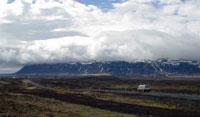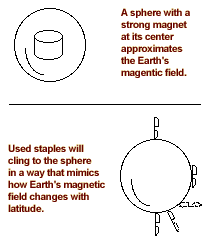|
|
|
|
||||||
The earth is a magnet with north and south poles. An electromagnet, to be specific. The Earth's magnetic field is created by electric currents which flow in the rotating and convecting liquid metal of the planet's outer core. We tend to think of the magnetic North and South poles as stationary (Santa's house doesn't move, in other words), but they're not. They drift over time, and neither of them are located exactly at the geographic poles. One magnetic pole is in Northern Canada, about 15 degrees of latitude from the geographic North Pole. The other is of the coast of Antarctica.
Over time, the poles drift enough to actually switch places, reversing each other. What does that mean? Think of it this way: if you use a compass today, the needle points toward magnetic north. If you used that same compass 700,000 years ago, it would point toward magnetic south. This reversal of the poles gives scientists clues about how the earth has been forming and changing over time. Especially in Iceland. Under ice in the nearby ocean, ridges and mountains have been created by volcanic activity over millions of years. When an eruption brings lava to the surface, the molten rock cools with a magnetism that matches that of the Earth at the time of the eruption. So if you're standing on a rocky mountainside made in an eruption 700,000 years ago, your compass will point to south. If you move up higher, to newer rock deposits, your compass will point north again. You can show yourself how a planet's magentic poles work. Try this! You can make a 3-D model of magnetic fields by inserting a small, strong magnet into a sphere. If you sprinkle used staples onto the sphere, you'll see the how the field works, as the orientation of the staples will change with "latitude."
You can buy a preassembled earth globe with a magnet already inside from Arbor Scientific, P.O. Box 2750, Ann Arbor, Michigan 48106 (1-800-367-6695) for about $15 (in 2000). Or you can make you own:
Assembly: If you're assembling your own magnetic earth, cut a slit in the Squeeshball, and insert the magnet into the center. Point one of the flat ends of the magnet toward the north pole of the earth. Reseal the ball with silicone seal or hot melt glue. Explore the magnetic field of the ball. If you place a used staple on the ball, the staple will stick to the ball and line up with the ball's magnetic field. Add more staples to the ball. Notice that the staples lie flat against the ball along a circle, this is the "magnetic equator. " At the "magnetic poles," the staples stand up vertically. Between the poles and the equator the staples stand up at different angles with respect to a plane tangent to the ball. The angle between the staple and the tangent plane is known as the "magnetic inclination" or the "dip of the magnetic field." Use a compass to explore the magnetic field surrounding the sphere. The field stretches away from the sphere; in the same way, the earthÕs magnetic field stretches far out into space. The earthÕs field traps charged particles from the sun making the Van Allen radiation belts. If the compass is held far from the magnetic sphere it will align itself with the magnetic field of the real earth rather than your earth model. Notice that in North America the north pole of the magnaprobe (red) points north and down. WhatÕs Going On? The earth is a magnet with magnetic north and south poles. Because it has only two poles, two places where the staples stand up vertically, its magnetic field is modeled by what is called a "dipole field." A sphere with a magnet inside creates a magnetic dipole like that of the earth. The staples will line up with this magnetic field. As the staples align, they show field lines that run between the north and south poles, they also show that the field over most of the sphere is not tangent to its surface. Although the magnetic field of this experiment is created by a permanent magnet, the earth is actually an electromagnet. The earth's magnetic field is created by electric currents which flow in the rotating and convecting liquid metal of the earthÕs outer core. A compass lines up with the earthÕs magnetic field, however, the pivot of the compass does not allow it to rotate up or down so it only shows the horizontal component of the field. |
|
|||||||
|
© 2001 Exploratorium |
||||||||


 What
do I need?
What
do I need?